
|
Great outburst occured on Oct. 24, 2007, and it bacame a naked eye comet of 2 mag. It kept so bright as 5.5 mag still on Apr. 30 (Carlos Labordena), but it was extremely faint and difficult to see. The size was so large, the diameter was larger than 60 arcmin. Now appearing in the morning sky, but still low. It will become observable in good condition in autumn again. The extremely faint large diffuse object may be detected with a best sky condition, around 5-6 mag with a diameter of 1 or 2 degrees.
Date(TT) R.A. (2000) Decl. Delta r Elong. m1 Best Time(A, h)
Aug. 23 8 14.33 29 29.0 4.516 3.700 32 6.1 5:06 (238, -6)
Aug. 30 8 22.63 28 60.0 4.485 3.726 36 6.1 4:57 (237, -4)
|

|
Now it is 6.6 mag (Aug. 22, Michael Mattiazzo). Its brightening became slow in July, however, it started brightening rapidly in August. It will reach up to 6.5 mag in September. It keeps moving in the southern sky, and it is unobservable for a while in the Northern Hemisphere. It will appear in the evening sky at 7 mag in ealy October, but it keeps locating in the evening low sky until the end of 2008 when it fades out down to 10 mag. Then it turns to appear in the morning sky, and it keeps observable in the northern sky after that while fading gradually. In the Southern Hemisphere, it keeps observable until late October.
Date(TT) R.A. (2000) Decl. Delta r Elong. m1 Best Time(A, h)
Aug. 23 11 15.67 -47 19.0 1.360 1.234 60 7.1 18:59 ( 49, 27)
Aug. 30 12 10.82 -45 40.9 1.331 1.182 58 6.8 19:03 ( 53, 30)
|
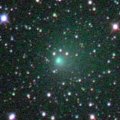
|
Now it is 8.7 mag (Aug. 23, Marco Goiato). Brightening rapidly as expected, and expanding the large coma. It will reach up to 8-9 mag and keep bright for a long time until autumn. In the Northern Hemisphere, it becomes low in the south at brightest, but it keeps observable until it fades out.
Date(TT) R.A. (2000) Decl. Delta r Elong. m1 Best Time(A, h)
Aug. 23 20 31.11 -24 31.8 0.375 1.357 153 9.0 22:23 (180, 80)
Aug. 30 20 46.69 -29 45.8 0.401 1.365 147 8.8 22:12 (180, 85)
|
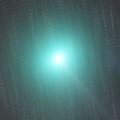
|
It became so bright as 4.7 mag, and so large as 20 arcmin in June (June 12, Marco Goiato). Now it is fading. But it is still bright as 9.1 mag (Aug. 24, Marco Goiato). It keeps observable in good condition for a long time after this. It will be visible visually until around November.
Date(TT) R.A. (2000) Decl. Delta r Elong. m1 Best Time(A, h)
Aug. 23 2 23.50 22 33.1 0.624 1.350 108 9.0 4:18 (180, 32)
Aug. 30 2 11.84 23 23.7 0.659 1.440 117 9.5 3:39 (180, 32)
|

|
Now it is so bright as 9.6 mag (Aug. 2, Juan Jose Gonzalez). The condition in this apparition is bad. In the Southern Hemisphere, it keeps extremely low, or under the horizon, so it will not be observable. In the Northern Hemisphere, it is finally appearing in the morning sky. It keeps observable and fading in the morning sky after this. Now it is brighter than originally expected.
Date(TT) R.A. (2000) Decl. Delta r Elong. m1 Best Time(A, h)
Aug. 23 7 55.02 26 53.6 2.106 1.404 35 10.6 5:06 (237, -1)
Aug. 30 8 19.67 27 30.9 2.101 1.427 36 10.7 4:57 (238, -2)
|

|
Now it is so bright as 9.7 mag (Aug. 13, Juan Jose Gonzalez). In the Northern Hemisphere, it keeps observable until 2009 spring when the comet becomes faint. It will move near by the Northern Pole from summer to autumn, and will be observable all night. It is about to start fading now, but it will be visible visually until around October. In the Southern Hemisphere, it will never be observable again.
Date(TT) R.A. (2000) Decl. Delta r Elong. m1 Best Time(A, h)
Aug. 23 16 1.49 87 54.9 1.708 1.803 78 11.0 18:59 (179,-33)
Aug. 30 13 55.46 86 56.5 1.732 1.832 79 11.3 19:03 (177,-33)
|
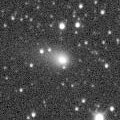
|
Now it is 10.3 mag (Aug. 22, Marco Goiato). Somewhat brighter than this ephemeris. It is expected to reach to 6 mag in 2009 February. It keeps observable until October.
Date(TT) R.A. (2000) Decl. Delta r Elong. m1 Best Time(A, h)
Aug. 23 17 51.12 -21 44.9 1.714 2.362 117 11.4 19:41 (180, 77)
Aug. 30 17 30.23 -21 39.5 1.787 2.284 106 11.3 19:03 (170, 76)
|
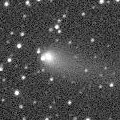
|
Now it is bright as 11.4 mag (Aug. 3, Carlos Labordena). Slightly fainter than originally expected, but brightening well. It will reach to 11 mag and will be observable in good condition in autumn. It keeps observable, visible visually, brighter than 14 mag for a long time until 2009 May.
Date(TT) R.A. (2000) Decl. Delta r Elong. m1 Best Time(A, h)
Aug. 23 4 21.01 52 21.8 2.426 2.446 79 11.5 5:06 (190, 1)
Aug. 30 4 38.89 53 42.7 2.362 2.438 82 11.5 4:57 (190, 0)
|
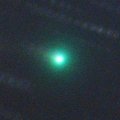
|
It brightened up to 9.2 mag on July 15 (Juan Jose Gonzalez). It is bright as 10.9 mag still on Aug. 9 (Juan Jose Gonzalez). Although it kept locating extremely low for a while in the Northern Hemisphere, it is getting higher gradually after this. It will be fading gradually after this, but it will be visible visually until September.
Date(TT) R.A. (2000) Decl. Delta r Elong. m1 Best Time(A, h)
Aug. 23 6 58.66 26 53.6 1.762 1.306 47 11.8 5:06 (229, 8)
Aug. 30 7 18.83 26 44.3 1.790 1.369 49 12.2 4:57 (229, 8)
|

|
It reached to 10.9 mag in May (May 11, Marco Goiato). Now it is fading slowly. It has already faded down to 12.0 mag (July 21, Alexandre Amorim). Not observable in the Northern Hemisphere. It will be unobservable soon also in the Southern Hemisphere. In the Northern Hemisphere, it will appear in the morning sky again at 13 mag at the end of 2008, then it keeps bright and observable for a while.
Date(TT) R.A. (2000) Decl. Delta r Elong. m1 Best Time(A, h)
Aug. 23 12 24.45 -3 4.7 3.557 2.812 36 12.0 18:59 ( 99, 18)
Aug. 30 12 35.56 -2 46.6 3.626 2.826 32 12.1 19:03 ( 96, 13)
|

|
Now it is bright as 11.5 mag (Aug. 4, Marco Goiato). It keeps bright at 12 mag for a long time from 2008 spring to 2009 spring. However, it moves southwards, and it will be unobservable soon in the Northern Hemisphere. It will appear in the northern sky again in 2009 autumn, but it will be fainter than 15 mag and will keep locating very low after that.
Date(TT) R.A. (2000) Decl. Delta r Elong. m1 Best Time(A, h)
Aug. 23 15 19.31 -37 17.1 2.654 2.796 87 12.1 18:59 ( 76, 68)
Aug. 30 15 17.26 -38 30.2 2.747 2.773 80 12.1 19:03 ( 72, 62)
|
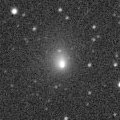
|
Brightening very rapidly, faster than expected. It is already so bright as 11.7 mag (Aug. 5, Jose Carvajal). It is expected to reach to 10 mag in 2009 summer. Because it moves in the northern sky, it keeps observable until it becomes brightest in the Northern Hemisphere.
Date(TT) R.A. (2000) Decl. Delta r Elong. m1 Best Time(A, h)
Aug. 23 3 58.22 69 33.7 4.382 4.327 80 13.0 5:06 (184,-15)
Aug. 30 3 48.51 71 7.0 4.249 4.284 85 12.9 4:57 (182,-16)
|
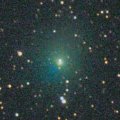
|
It reached up to 9.5 mag on Mar. 29 (Maik Meyer). Now it is fading slowly. It faded down to 10.7 mag on May 11 (Marco Goiato), and it was a diffuse object with a weak condensation. In the Northern Hemisphere, it will never be observable again. In the Southern Hemisphere, it keeps observable until it fades out. No observations have been reported recently, and the current brightness is uncertain.
Date(TT) R.A. (2000) Decl. Delta r Elong. m1 Best Time(A, h)
Aug. 23 10 23.14 -40 48.2 2.699 2.230 52 13.9 18:59 ( 50, 15)
Aug. 30 10 40.03 -43 20.5 2.779 2.305 52 14.1 19:03 ( 46, 14)
|

|
In the last season, it became so bright as 10 mag in 2008 January. Although it had been unobservable for a while, now it is appearing in the morning sky.
Date(TT) R.A. (2000) Decl. Delta r Elong. m1 Best Time(A, h)
Aug. 23 7 44.85 24 48.4 6.836 6.054 36 14.0 5:06 (238, 2)
Aug. 30 7 49.89 24 34.3 6.767 6.056 42 14.0 4:57 (236, 5)
|

|
Now it is bright as 12.7 mag (Apr. 12, Marco Goiato). It will never be observable again in the Northern Hemisphere. In the Southern Hemisphere, it will be unobservable in October, but it will appear again in the morning sky at 15 mag in winter.
Date(TT) R.A. (2000) Decl. Delta r Elong. m1 Best Time(A, h)
Aug. 23 13 8.34 -18 18.6 3.466 2.975 53 14.1 18:59 ( 91, 35)
Aug. 30 13 17.87 -19 45.8 3.532 2.976 49 14.2 19:03 ( 86, 31)
|

|
It was 15 mag on Jan. 14 (Michael Mattiazzo), brightening as expected. Now it must have reached up to 13.5 mag in the southern sky. In the Southern Hemisphere, it keeps observable for a long time after this. But in the Northern Hemisphere, it is not observable now. But it will appear in the morning sky at 15 mag in November, then it keeps observable while the comet will be fading slowly.
Date(TT) R.A. (2000) Decl. Delta r Elong. m1 Best Time(A, h)
Aug. 23 9 47.88 -32 4.4 3.274 2.639 43 14.3 5:06 (301, 11)
Aug. 30 10 2.32 -31 36.6 3.338 2.664 41 14.4 4:57 (300, 12)
|

|
Now it is 12.7 mag (Aug. 1, Juan Jose Gonzalez), bright and visible visually. It will be getting lower in the evening sky after this, and will be too low to observe in October. But it will locate high again in winter, and will be visible visually at 14 mag.
Date(TT) R.A. (2000) Decl. Delta r Elong. m1 Best Time(A, h)
Aug. 23 14 53.56 20 44.0 6.109 5.816 68 14.5 18:59 (145, 26)
Aug. 30 14 52.75 20 20.7 6.216 5.830 63 14.5 19:03 (138, 22)
|

|
Now it is 15.1 mag (Aug. 1, John Drummond). It is not observable in the Northern Hemisphere now, but observable in good condition in the Southern Hemisphere. It is expected to brighten up to 10 mag from late 2009 to early 2010. Because the comet moves in the southern sky for a long time, it keeps impossible or very hard to observe in the Northern Hemisphere until 2009 September. But after 2009 October, it is observable at 10 mag for a while in good condition. In the Southern Hemisphere, it keeps observable for a long time while brightening until 2009 June when it brightens to 11 mag. But it becomes unobservable around and after the brightest time.
Date(TT) R.A. (2000) Decl. Delta r Elong. m1 Best Time(A, h)
Aug. 23 5 43.86 -40 30.9 4.897 4.827 80 14.6 5:06 (292, 60)
Aug. 30 5 50.36 -41 21.6 4.804 4.771 82 14.5 4:57 (294, 62)
|

|
It had been so faint as 18 mag until July. However, an outburst occured on Aug. 3 and brightened up to 14.5 mag (Gustavo Muler). It is bright as 14.5 mag still on Aug. 15 (Ken-ichi Kadota). However, it will fade out rapidly after this.
Date(TT) R.A. (2000) Decl. Delta r Elong. m1 Best Time(A, h)
Aug. 23 14 47.89 -1 12.5 3.546 3.346 70 14.7 18:59 (129, 43)
Aug. 30 14 53.77 -2 28.5 3.611 3.324 65 14.8 19:03 (121, 40)
|

|
An outburst occured in late May, and it brightened up to 14.6 mag (May 23, Gustavo Muler). However, it faded down to the original brightness in late May. Now it is 17.3 mag (June 24, Catalina Sky Survey). It will reach to 14 mag in autumn, but it locates extremely low in the Northern Hemisphere. It is reported fainter than this ephemeris recently.
Date(TT) R.A. (2000) Decl. Delta r Elong. m1 Best Time(A, h)
Aug. 23 13 31.58 1 38.7 1.695 1.322 51 15.4 18:59 (114, 28)
Aug. 30 13 50.53 -1 53.3 1.690 1.298 50 15.2 19:03 (109, 28)
|
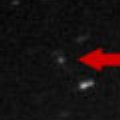
|
Now it is 16.2 mag (Aug. 3, Ken-ichi Kadota). It keeps observable while the comet will be brightening gradually after this. It will reach up to 14.5 mag in autumn. However, then it locates low in the evening sky, and it will be unobservable soon in December.
Date(TT) R.A. (2000) Decl. Delta r Elong. m1 Best Time(A, h)
Aug. 23 15 44.57 -7 33.7 2.159 2.313 85 15.5 18:59 (141, 57)
Aug. 30 15 52.22 -8 24.8 2.198 2.271 81 15.4 19:03 (131, 54)
|

|
Now it is 14.8 mag (July 29, M. Tichy). Now it is brightest, and it will be fading after this. It keeps observable in good condition until it fades out in winter. The position is very different from the original prediction.
Date(TT) R.A. (2000) Decl. Delta r Elong. m1 Best Time(A, h)
Aug. 23 4 5.25 15 26.4 1.531 1.803 87 15.6 5:06 (196, 38)
Aug. 30 4 16.68 15 58.2 1.492 1.827 91 15.7 4:57 (194, 38)
|
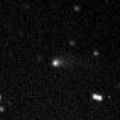
|
Now it is 15.6 mag (July 28, Ken-ichi Kadota). It will be 15.5 mag until October. It locates somewhat low in the Northern Hemisphere, but it keeps observable around 16 mag until winter. It is also observed visually at 14.6 mag (Aug. 6, Juan Jose Gonzalez).
Date(TT) R.A. (2000) Decl. Delta r Elong. m1 Best Time(A, h)
Aug. 23 21 9.92 -29 22.2 1.989 2.949 157 15.6 23:01 (180, 84)
Aug. 30 21 4.87 -29 5.2 2.013 2.937 150 15.6 22:28 (180, 84)
|

|
It is expected to reach up to 7 mag in winter, and will be observable in good condition. However, this comet has not been observed since 1986. It was not detected, fainter than 18 mag, on May 31 (Katsumi Yoshimoto). Nothing brighter than 20.6 mag was found around the predicted position on June 12 (Mitsunori Tsumura). It is predicted to be brightening up to around 16 mag, bright enough to be recovered. It will brighten very rapidly near by the perihelion. The condition of this apparition is good. It keeps observable for a long time until 2009 early summer both in the Northern Hemisphere and Southern Hemisphere.
Date(TT) R.A. (2000) Decl. Delta r Elong. m1 Best Time(A, h)
Aug. 23 19 47.99 -25 23.0 0.987 1.900 143 16.4 21:39 (180, 80)
Aug. 30 19 40.87 -25 14.5 0.971 1.835 135 15.8 21:04 (180, 80)
|
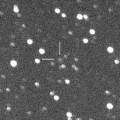
|
Now it is 15.8 mag (Aug. 7, Ken-ichi Kadota). It will be observable at 15.5 mag in good condition in next autumn.
Date(TT) R.A. (2000) Decl. Delta r Elong. m1 Best Time(A, h)
Aug. 23 4 4.20 22 35.6 3.234 3.333 86 15.9 5:06 (194, 31)
Aug. 30 3 56.92 23 0.2 3.093 3.336 94 15.8 4:57 (187, 32)
|

|
Not it is 16.5 mag (July 31, Gustavo Muler). It will be brightening gradually after this, and reach to 12-13 mag in 2009 winter and spring. In the Northern Hemisphere, it keeps observable for a long time until 2009 May.
Date(TT) R.A. (2000) Decl. Delta r Elong. m1 Best Time(A, h)
Aug. 23 21 14.38 -28 29.2 1.420 2.390 158 16.1 23:05 (180, 83)
Aug. 30 21 6.02 -28 56.4 1.402 2.338 151 16.0 22:29 (180, 84)
|

|
It must have already brightened up to 17 mag. However, it was not detected, fainter than 18.5 mag on Aug. 2 (Giovanni Sostero and Ernesto Guido). It is expected to brighten rapidly after this and reach up to 10 mag in winter. However, it may be much fainter than expected in fact. It keeps observable in good condition for a long time until early summer in next year when the comet fades out.
Date(TT) R.A. (2000) Decl. Delta r Elong. m1 Best Time(A, h)
Aug. 23 2 42.94 19 55.4 1.691 2.192 105 16.7 4:37 (180, 35)
Aug. 30 2 51.37 20 35.6 1.572 2.143 110 16.3 4:18 (180, 34)
|

|
Now it is 16.8 mag (July 13, Gustavo Muler). It will be observable at 16 mag in good condition in autumn.
Date(TT) R.A. (2000) Decl. Delta r Elong. m1 Best Time(A, h)
Aug. 23 3 3.60 12 32.4 1.639 2.111 103 16.4 4:57 (180, 42)
Aug. 30 3 11.97 12 35.8 1.568 2.109 107 16.3 4:38 (180, 42)
|

|
Now it is 16.0 mag (June 30, Michael Jager). It keeps observable in good condition after this in the Northern Hemisphere. It will be fading gradually, and will be fainter than 18 mag in November.
Date(TT) R.A. (2000) Decl. Delta r Elong. m1 Best Time(A, h)
Aug. 23 22 54.83 56 14.8 2.008 2.560 111 16.6 0:50 (180, -1)
Aug. 30 22 44.46 57 21.8 2.036 2.610 113 16.7 0:12 (180, -2)
|

|
Not recovered yet. But now it is brightest, and it should be arond 16.5 mag. It will getting higher, but will be fading gradually after this. It will be fainter than 18 mag in December.
Date(TT) R.A. (2000) Decl. Delta r Elong. m1 Best Time(A, h)
Aug. 23 7 9.71 25 41.9 1.882 1.361 44 16.7 5:06 (231, 7)
Aug. 30 7 34.87 25 18.4 1.877 1.375 45 16.8 4:57 (233, 7)
|

|
It was observed at 16.5-17 mag in 2007 autumn. Now it is 17.3 mag (July 2, J. F. Hernandez). It will be observable at 17 mag for a long time from summer to autumn.
Date(TT) R.A. (2000) Decl. Delta r Elong. m1 Best Time(A, h)
Aug. 23 4 36.26 27 8.8 2.517 2.524 78 17.0 5:06 (201, 25)
Aug. 30 4 44.60 27 28.4 2.457 2.550 83 17.1 4:57 (198, 25)
|
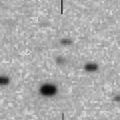
|
It will be observable at 17 mag in good condition in autumn.
Date(TT) R.A. (2000) Decl. Delta r Elong. m1 Best Time(A, h)
Aug. 23 0 58.37 30 18.1 1.621 2.318 121 17.2 2:53 (180, 25)
Aug. 30 1 0.75 29 58.8 1.562 2.319 127 17.1 2:27 (180, 25)
|

|
Now it is 17.8 mag (Aug. 3, Ken-ichi Kadota). It will brighten up to 12 mag in 2012. It is faint still in 2008, but observable at 17 mag in good condition.
Date(TT) R.A. (2000) Decl. Delta r Elong. m1 Best Time(A, h)
Aug. 23 23 15.96 7 40.5 9.651 10.574 154 17.2 1:11 (180, 47)
Aug. 30 23 12.56 7 24.1 9.576 10.536 161 17.1 0:40 (180, 48)
|

|
It was observed at 17.5-18 mag in 2006 and 2007. In 20080, it will be observable at 17.5-18 mag from summer to autumn.
Date(TT) R.A. (2000) Decl. Delta r Elong. m1 Best Time(A, h)
Aug. 23 22 44.18 -22 49.6 3.167 4.154 165 17.3 0:39 (180, 78)
Aug. 30 22 40.41 -23 33.9 3.172 4.157 165 17.3 0:08 (180, 78)
|

|
Observable at 17.5 mag in autumn. Because it is a distant comet, it will be observable at 17.5 mag in 2009 autumn again. Although it locates low this year, it will locate high and observable in good condition in 2009.
Date(TT) R.A. (2000) Decl. Delta r Elong. m1 Best Time(A, h)
Aug. 23 21 14.67 -17 28.9 2.906 3.893 165 17.4 23:05 (180, 72)
Aug. 30 21 10.52 -17 33.2 2.934 3.888 157 17.4 22:34 (180, 73)
|
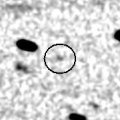
|
Now it is 18.2 mag (July 2, J. M. Ruiz M.). It will be observable at 16 mag in good condition from autumn to winter.
Date(TT) R.A. (2000) Decl. Delta r Elong. m1 Best Time(A, h)
Aug. 23 2 27.57 25 42.7 2.308 2.777 106 17.7 4:22 (180, 29)
Aug. 30 2 31.40 26 33.5 2.202 2.751 112 17.5 3:58 (180, 28)
|
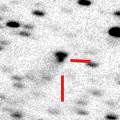
|
It was observed at 16.5-17 mag in 2006 and 2007. Because it is a very distant comet, it is observable at 17 mag still in 2008 in good condition.
Date(TT) R.A. (2000) Decl. Delta r Elong. m1 Best Time(A, h)
Aug. 23 17 44.04 43 4.2 6.263 6.496 98 17.6 19:35 (180, 12)
Aug. 30 17 39.53 42 28.9 6.340 6.517 95 17.7 19:03 (180, 13)
|

|
It reached up to 16 mag last winter. Now it is fading, but it will be observable at 17.5 mag in good condition from autumn to winter.
Date(TT) R.A. (2000) Decl. Delta r Elong. m1 Best Time(A, h)
Aug. 23 5 1.01 13 25.3 5.640 5.464 74 17.6 5:06 (213, 35)
Aug. 30 5 3.16 13 50.0 5.564 5.496 80 17.6 4:57 (208, 36)
|
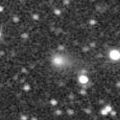
|
It was bright as 12.7 mag on May 12 (Juan Jose Gonzalez), and strongly condensed. However, it has been getting diffuse and fading rapidly after that. Now it is 16.6 mag (July 5, Ken-ichi Kadota). A temporary outburst has ended. It keeps observable in good condition until autumn. But it is moving southwards gradually, and the altitude will be getting somewhat lower in the Northern Hemisphere. It must be already too faint to see visually.
Date(TT) R.A. (2000) Decl. Delta r Elong. m1 Best Time(A, h)
Aug. 23 16 43.37 -21 29.6 2.177 2.585 102 17.8 18:59 (158, 76)
Aug. 30 16 50.02 -22 5.5 2.277 2.600 96 18.1 19:03 (137, 73)
|

|
Not recovered yet. But now it should be brightening up to 18 mag. It will reach up to 16 mag in October and November, and will be observable in good condition. It keeps observable in the morning sky until January when it will be fainter than 18 mag.
Date(TT) R.A. (2000) Decl. Delta r Elong. m1 Best Time(A, h)
Aug. 23 4 56.71 20 17.8 1.332 1.448 74 18.2 5:06 (208, 29)
Aug. 30 5 26.52 19 59.0 1.242 1.379 74 17.9 4:57 (211, 29)
|

|
Peculiar asteroid moving along a cometary orbit with a period of 40 years. It will be observable at 18 mag in good condition from August to September. It has already passed the perihelion in May.
Date(TT) R.A. (2000) Decl. Delta r Elong. m1 Best Time(A, h)
Aug. 23 22 16.71 6 47.9 2.136 3.113 161 17.9 0:12 (180, 48)
Aug. 30 22 11.47 7 17.6 2.150 3.129 162 17.9 23:34 (180, 48)
|

|
It was predicted to be so bright as 14 mag now. But actually, it is extremely faint as 19.5 mag (Aug. 4, Gustavo Muler). Although it locates in good condition, it will be hard to observe.
Date(TT) R.A. (2000) Decl. Delta r Elong. m1 Best Time(A, h)
Aug. 23 22 13.93 16 31.7 1.576 2.514 152 19.9 0:09 (180, 38)
Aug. 30 22 10.32 16 16.6 1.615 2.561 154 20.0 23:33 (180, 39)
|

|
It was observed at 16-17 mag at the discovery in 1999. It is predicted to be already 18 mag. But actually, it was not detected, fainter than 22.5 mag, in 2006 September (Carl Hergenrother). So it must be now fainter than at the discovery by 3-4 mag.
Date(TT) R.A. (2000) Decl. Delta r Elong. m1 Best Time(A, h)
Aug. 23 0 14.55 5 20.7 3.268 4.133 144 21.2 2:09 (180, 50)
Aug. 30 0 11.76 5 8.1 3.197 4.115 151 21.1 1:39 (180, 50)
|
|
![]()
 199P/2008 G2 ( Shoemaker 4 )
199P/2008 G2 ( Shoemaker 4 ) 7P/Pons-Winnecke
7P/Pons-Winnecke 68P/Klemola
68P/Klemola 51P/Harrington
51P/Harrington 47P/Ashbrook-Jackson
47P/Ashbrook-Jackson 85P/Boethin
85P/Boethin C/2007 U1 ( LINEAR )
C/2007 U1 ( LINEAR ) 67P/Churyumov-Gerasimenko
67P/Churyumov-Gerasimenko 144P/Kushida
144P/Kushida 61P/Shajn-Schaldach
61P/Shajn-Schaldach C/2008 J6 ( Hill )
C/2008 J6 ( Hill ) P/2001 R1 ( LONEOS )
P/2001 R1 ( LONEOS ) 44P/Reinmuth 2
44P/Reinmuth 2 P/2008 L2 ( Hill )
P/2008 L2 ( Hill ) C/2006 S3 ( LONEOS )
C/2006 S3 ( LONEOS ) P/2006 F1 ( Kowalski )
P/2006 F1 ( Kowalski ) P/2008 O2 ( McNaught )
P/2008 O2 ( McNaught ) 59P/Kearns-Kwee
59P/Kearns-Kwee C/2005 S4 ( McNaught )
C/2005 S4 ( McNaught ) C/2006 K1 ( McNaught )
C/2006 K1 ( McNaught ) P/2008 J2 ( Beshore )
P/2008 J2 ( Beshore ) P/2001 J1 ( NEAT )
P/2001 J1 ( NEAT ) 2008 JS14
2008 JS14 C/2007 K3 ( Siding Spring )
C/2007 K3 ( Siding Spring ) P/1999 WJ7 ( Korlevic )
P/1999 WJ7 ( Korlevic )![]()































